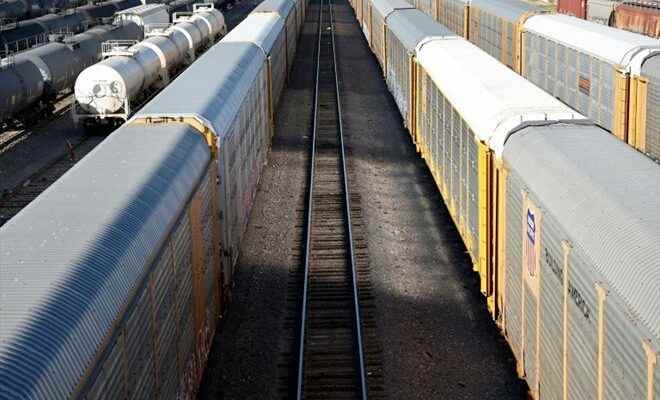Freight trains at a depot in Wilmington, Calif. (GETTY IMAGES NORTH AMERICA/AFP/MARIO TAMA)
The elected members of the House of Representatives intervened directly on Wednesday to unblock a social conflict and avoid a potentially catastrophic rail freight strike for the United States economy.
This bill, adopted by a majority of elected members of the lower house of Congress, imposes a branch agreement on the profession, although it has not been approved by all the social partners. It must now be passed by the Senate.
Faced with the prospect of a possible strike from December 9, US President Joe Biden had decided to entrust the file to Congress, empowered by a 1926 law to impose the adoption of an agreement in the event of an impasse in the negotiations.
“The president expects a text to be submitted to him by next weekend,” commented White House spokeswoman Karine Jean-Pierre after the vote during a press briefing.
The preliminary agreement, with retroactive application to 2020 and which extends until 2025, had been signed by eight of the twelve unions in the sector, but the four refractory organizations said they were ready to call on their members to stop work.
The text provides for a salary increase of 24% over the five-year period from 2020 to 2024 (with retroactive effect), with a salary increase of 14.1% with immediate effect, as well as five annual bonuses of 1,000 dollars each.
Speaker of the House of Representatives, Nancy Pelosi, justified the decision to go through the legislative process to freeze the new collective agreement for rail freight by the need to “protect the American economy which continues to recover and to avoid the devastating stoppage of rail at the national level”.
A freight strike would have cut US economic activity by two billion dollars a day, according to an estimate by the American Railroad Association.
In 2020, about 28% of the goods transported in the United States are by rail, according to the company Union Pacific.
– Political risk eliminated –
As 97% of the network used by the national rail company Amtrak is managed by freight operators, a strike would also have had considerable repercussions for passenger traffic.
The prospect of a U.S. rail paralysis also presented a major political risk for President Joe Biden, as inflation remains high and the U.S. economy already shows signs of slowing.
But by forcing the adoption of the collective agreement and bypassing social dialogue, the head of state exposed himself to criticism from unions and the left wing of the Democratic Party.
In an attempt to rally the opponents, the Democrats presented a complementary bill on Wednesday which provides for seven days of guaranteed sick leave per year.
Sick leave had crystallized the dissatisfaction of many employees in the sector, some companies not granting any in the state.
This second text was adopted following the vote on the agreement itself.
Before the vote, three of the four refractory unions had come out of their principled opposition to the intervention of politics, and had called on Congress to adopt the additional text on sick leave.
After the adoption in the House, one of the four unions, the BMWED, “applauded the elected officials (…) who supported the proposal for sick leave for freight railway workers”.
The organization, however, launched a spade at parliamentarians, in a tweet: “Did you know? Members of Congress have unlimited sick leave”.
During his daily press briefing, White House spokeswoman Karine Jean-Pierre indicated that Joe Biden had reservations about using a second text.
“Of course, the president is in favor of sick leave (…), but he does not support a text or an amendment which would delay the arrival of the (bill on the agreement) on his desk by Saturday” , she said.
Despite this transition into political force, Joe Biden remains “the most union-friendly president in the history” of the United States, insisted Karine Jean-Pierre.
© 2022 AFP
Did you like this article ? Share it with your friends with the buttons below.




